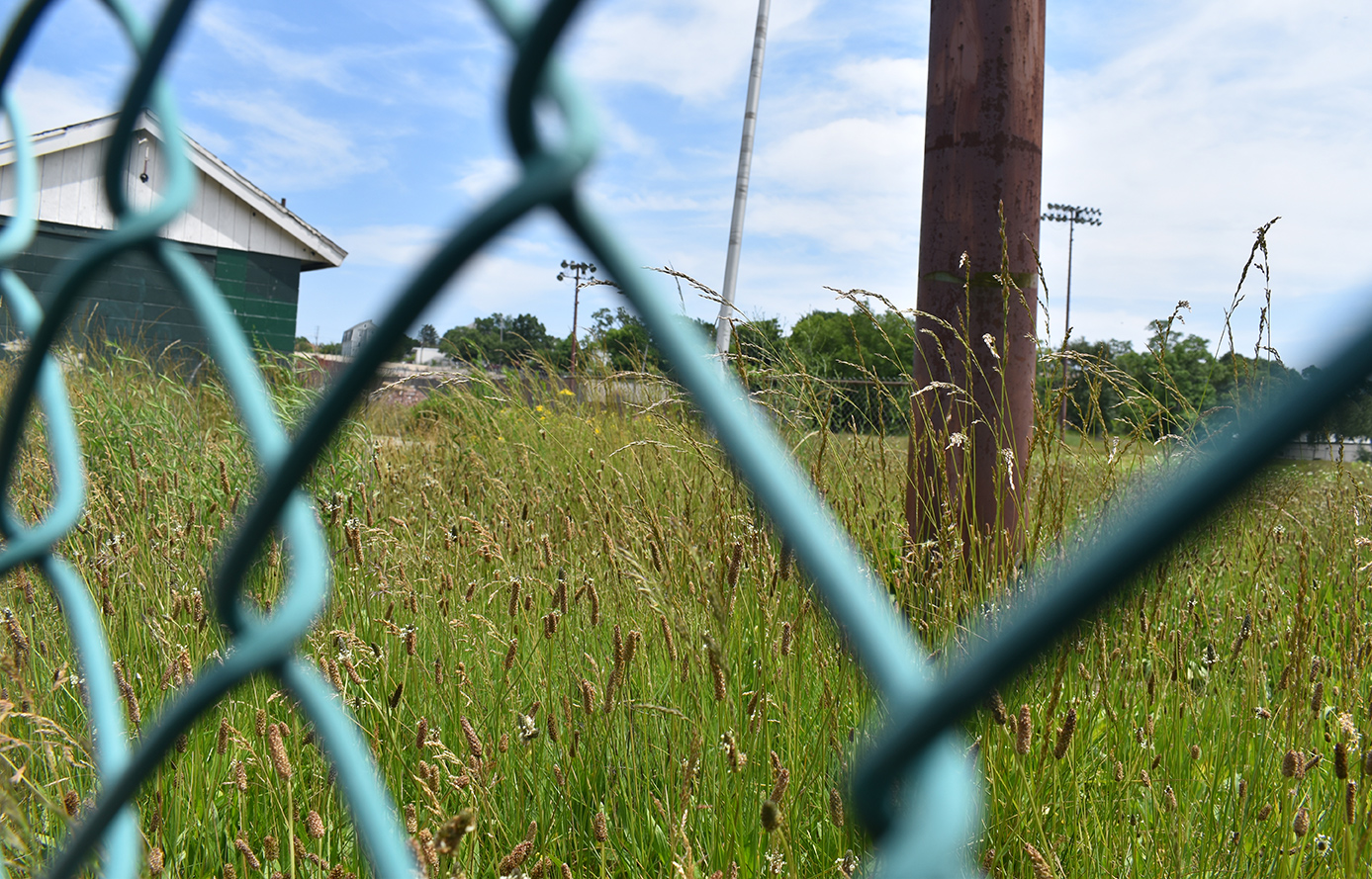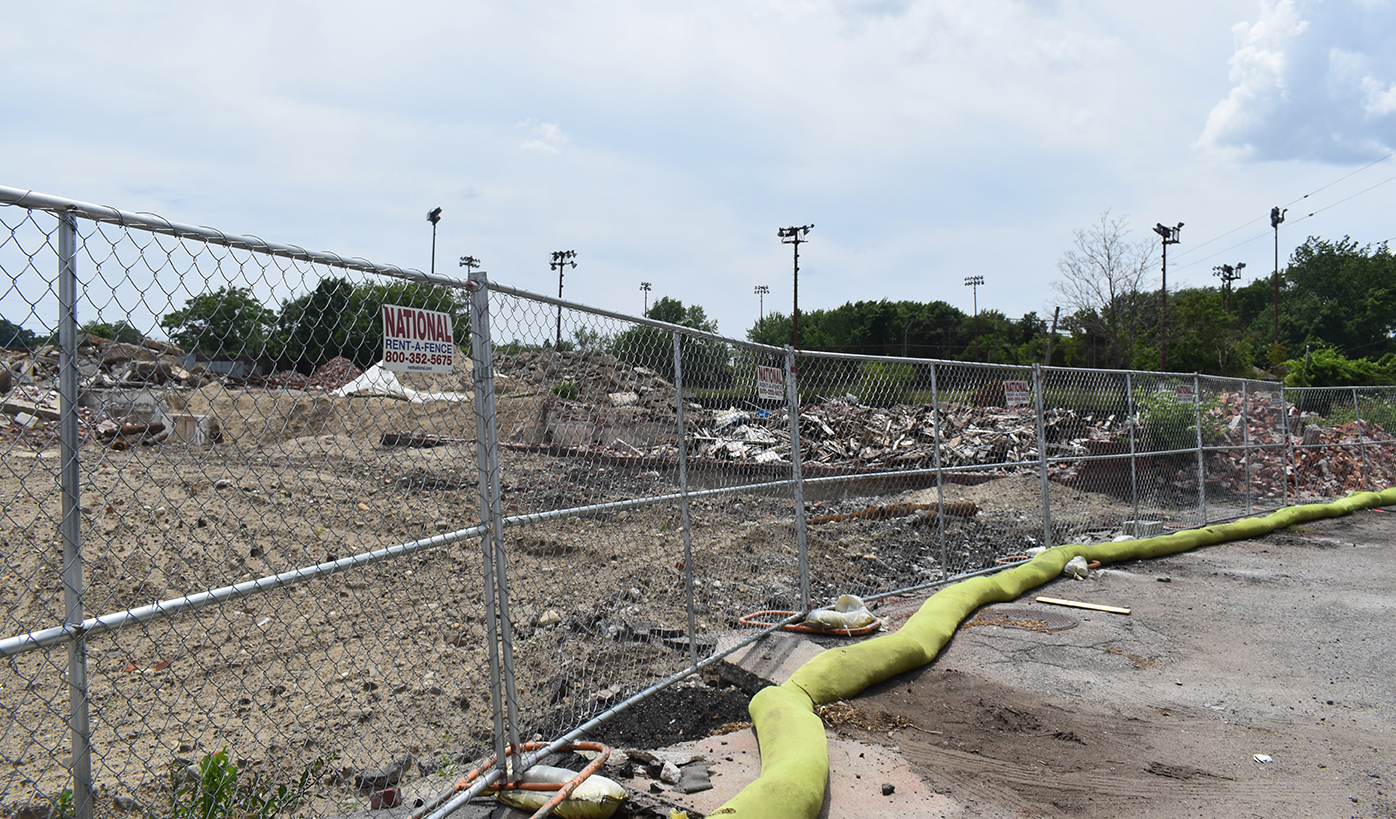Pawtucket City Hall’s Drive to Transform Public Green Space Into Blacktop
Marginalized neighborhood would be left without a park
June 22, 2023
PAWTUCKET, R.I. — To influential local officials, the only public park in the city’s Woodlawn neighborhood is worth little attention and half a million dollars. But for many others, William H. Morley Memorial Field is a priceless oasis in an asphalt desert.
Morely Field, as it is commonly known, resides in the lowest-scoring city neighborhood when it comes to tree cover and green space, according to Woodlawn’s American Forests Tree Equity Score. In fact, the neighborhood has one of the lowest scores in all of Rhode Island.
City officials, in May 2021, introduced the idea of selling Morley Field to JK Equities LLC for a reported $500,000, so the only green space in an environmental justice neighborhood could be paved over and turned into a parking lot for a redeveloped distribution center next door. The park also offers the city’s only public access to the Moshassuck River without having to cut through a cemetery.
The paving plan for the 5-acre park quickly sparked significant backlash from residents, both local and citywide, some local officials, and out-of-town advocates. Community pushback — and the law — have since reduced the proposed project by 40%.
Morley Field advocates are now working to reduce the parking lot plan by another 60%.
City Council member Clovis Gregor, who represents the neighborhoods of Woodlawn and Oak Hill that make up District 5, repeatedly stressed to city officials that selling one of the two lots that make up Morley Field was illegal, because the 2-acre parcel, identified as Plat 62A/Lot 291, was donated to the city five decades ago to be used as an athletic field. He and his three sons played sports at Morley Field.
Gregor, who grew up in the neighborhood along the Providence line that is 74% people of color, with 59% living at or below the poverty rate, has called the plan insulting, noting “this largely and historically underserved minority community” could lose its only green space.
For those who have told him Woodlawn is home to Payne Park, Gregor has called their suggestion an “exaggeration,” noting the West Avenue facility is a basketball court and playground with a tiny slice of green.

Morley Field, 94 Moshassuck St., is a public recreation facility that was created in the 1970s, but disregarded by the city for the past decade. Park supporters say the property became underutilized because it was deliberately neglected. It was supposed to be maintained to certain standards but has been left to crumble. Rotted-out steps lead to the park’s south-side entrance on Grenville Street.
A hired spokesperson for the city noted last year that redevelopment is necessary because of the neglected and dangerous state of Morley Field. The park is trashed because it’s a property City Hall abandoned in a neighborhood the city doesn’t seem to care about.
While Morley Field has been left to wither, recreational fields in the Fairlawn neighborhood have been upgraded, and across the Seekonk River on the other side of the city is well-maintained Slater Memorial Park along the banks of Ten Mile River. There are no plans to pave over Slater Memorial Park and send more polluted stormwater into the adjacent river.
Last October, the city issued a press release claiming the “City Council approved a compromise that saves a large original portion of Morley Field while allowing JK Equities to move forward with construction of a distribution facility.”
With whom the compromise was reached remains a mystery. The law required leaving out the park’s 2-acre parcel. Gregor recently told ecoRI News that no such agreement has been reached. The concerns of park advocates remain.
On a recent Wednesday afternoon, ecoRI News met with six people, including Gregor, at Morley Field to discuss the ease with which City Hall decided the mostly paved-over Woodlawn neighborhood didn’t need any public green space of its own. (Their voices and their concerns can be heard by clicking on playheads embedded in this story.)
Rep. Cherie Cruz, D-Pawtucket, grew up in the Woodlawn neighborhood. Her brothers, in the late 1970s and early ’80s, played at Morley Field. She called the taking of the park a “City Hall deal.” She said the community’s concerns, needs, and well-being were not adequately taken into consideration.
“I’m here as an advocate, community member, and a new state representative trying to do everything I can to make sure we save this field that came from a good place,” she said. “Donated to this community because they saw the need — a need that still exists today.”
Morley Field was fenced off shortly after the selling of the park was introduced. The city has said it was a precautionary measure after soil tests conducted on the property found lead and polycyclic aromatic hydrocarbons at some locations at concentrations above acceptable levels.
A letter sent last June to the City Council by the public works director claims the contamination was investigated by the state Department of Environmental Management.
The testing of Morley Field’s two lots, according to Gregor, was funded by JK Equities/Blackstone Distribution Center. He said the director’s “letter deliberately misstates who initiated and conducted the environmental investigation testing.” The testing was conducted for JK Equities/Blackstone Distribution Center by the Alliance Environmental Group based on DEM policy.
In a recent email to ecoRI News, DEM’s chief public affairs officer, Michael Healey, noted “we did not conduct the actual tests.”
“JK Equities LLC hired an environmental consultant and the consultant took soil samples, had them tested at a licensed lab, and submitted the results to DEM,” he wrote. “This is standard operating procedure according to the reporting requirements and it’s done at the request of the lender or as part of a liability determination for a property transaction.”
Gregor said the city has engaged in public misinformation, such as the Oct. 19, 2022, compromise press release, when it comes to matters involving Morley Field. He said closing the park to a neighborhood that contains predominately multifamily triple-deckers with limited yard space was an overreaction to the findings. He noted DEM didn’t recommend the field be closed.
“When my family first migrated to the United States, we lived in a three-family tenement house [in the Woodlawn neighborhood] … so we had no yard to play in,” Gregor said. “The landlord had gardens and such and obviously would get upset if we played in the yard, as he was afraid we would damage his crops and flowers. So it was either we would play on the street, or we would come here to Morley Field, because I lived literally like a five-minute walk from there.”
The city was quick to react to the results someone else paid for, but it was never concerned enough before to have Morley Field tested for contamination.
The city acquired the property consisting of two parcels through a National Park Service grant (3 acres) and as a gift (2 acres). It hosted baseball and football games and soccer matches. It features lighting and restrooms.

JK Equities has requested the park’s zoning be changed from public open to industrial. The New York-based real estate company wants to redevelop the old Microfibres Inc. factory — the 90-year-old textile company filed for bankruptcy in 2016 — next to Morley Field into a last-mile distribution center, owned and operated by Blackstone Distribution Center LLC.
JK Equities has had the former Microfibres buildings demolished, with plans to develop a 165,000-square-foot distribution facility and few dozen loading docks.
The redevelopment of the 10-acre Microfibres site and the paving over of the abutting park is supported by the mayor, a slim majority of the City Council, the Zoning Board of Appeals, and the City Planning Commission. JK Equities has listed the property, and representatives have told local officials the proposed distribution center has drawn significant national interest.
Total petroleum hydrocarbons, arsenic, and chrysene were detected at the former Microfibres site at concentrations above safe standards, according to a site investigation report prepared by the Alliance Environmental Group in March 2021.
Three acres of the two-parcel park would be used to bury some 1,400 tons of contaminated dirt and debris that needs to be removed from the site. More than half the park would then be capped, paved over, and turned into a parking lot. The plan is for the remaining 2 acres the city is unable to include in the sale to be turned into a passive park.
While the city was quick to fence off Morley Field, to allegedly protect residents, it was slow to protect those same residents from the toxic materials unearthed during the demolition and excavation of the former textile site.

Gregor said contaminated piles of debris sat for about a month with no effort to mitigate toxic dust from blowing around and polluted stormwater from rushing away. He noted the fencing wasn’t sufficient to keep curious kids from exploring the rubble.
His concerns about the haphazard way the site was left prompted him to contact DEM. The agency inspected the site in May, finding covered dirt piles and some erosion and stormwater controls in place. A DEM official told him the agency would be contacting the owner and the contractor hired to conduct the demolition to better secure the piles, improve erosion and stormwater controls, and secure the perimeter fencing.
Gregor also sent the city’s director of zoning and code enforcement a letter dated April 26 expressing his concerns about the demolition work at the Microfibres site, noting an absence of safety measures and calling it “an urgent public and environmental safety concern.”
“[M]y concerns are based on the current excavation activities and conditions of the site which I fear may be endangering our residents’ health and safety as well as polluting our local environment including the Moshassuck River and Morley Field,” he wrote.

When ecoRI News visited the site June 14, the perimeter fencing seemed pretty secure and a yellowish-green mesh log circled much of it, but piles of debris — dirt, concrete, and brick — were uncovered. The one cover observed, hanging like an apron off a mound of dirt, left the pile mostly exposed.
Gregor said there is federal money and foundation grants available that would allow the city to rehabilitate the park, add a track, and maintain the green space.
“We could make this a beautiful place again without costing taxpayers anything,” he said.
Since the 3-acre parcel, identified as Plat 62A/Lot 309, was bought by the city with money from a National Park Service grant, the city is required to replace the green space, and the replacement property has to be approved by the federal government.
The city has agreed to sell the 3-acre lot to JK Equities for $280,000, and the out-of-state developer has agreed to pay an additional $1.5 million to offset the cost of replacing the park. The deal, according to Gregor, also includes a 20-year, transferable tax stabilization agreement that he said will basically wipe out the $1.78 million in JK Equities sale/offset money.
The city’s search for a replacement property was required to begin in District 5. Pawtucket’s planning director told the City Council last September that no such substitute property could be found in the neighborhoods of Woodlawn or Oak Hill. The city did find a parcel in a more affluent, whiter neighborhood about a mile from Morley Field. The 9.5 acres of undeveloped land on the city’s south side sits between Riverside Cemetery and Max Read Field.
The mayor’s office has said the Pleasant Street property in District 4 would create additional green space and new recreation opportunities for the city.
The problem, according to Gregor, is that the densely populated neighborhoods he represents will be left without any green space. He maintains the city never made finding replacement space in his district a priority.
Gregor has called the plan to create more recreational room and open space between an athletic complex and a cemetery “redundant and absurd.” He has noted Woodlawn children — 18 and younger — represent the highest per capita percentage of children in the city and they could end up with no access to any in-district green space.
Councilor-At-Large Michael Araujo has noted the proposed distribution center would bring needed jobs to the community. He has said instead of talking about taking green space away, the talk should be about jobs.
Mayor Donald Grebien has shared similar comments, saying the paving of the park would help create new jobs and spur economic development.
But there is no guarantee on how many jobs will be created — guesstimates of 130 to 450 have been thrown about — because that decision ultimately lies with the company that leases the site. There is no guarantee neighborhood or even Pawtucket residents would be hired.
Before the city fenced off the park and after City Hall stopped caring about its upkeep, it was used, mostly by adults, for walking, running, relaxing, and exercising dogs.
Providence resident Greg Gerritt, founder of Friends of the Moshassuck, is one of those adults. From the other side of the chain-link fence, he videotapes Morley Field’s wildlife. He most recent video shows a mother feeding her chicks in nest in one of the park’s light towers.
He is frustrated and angry that the city has little understanding of, or is ignoring, the importance green space plays in the well-being of low-wealth neighborhoods.
“It was a scam from day one,” Gerritt said. “They were hoping to slide it through and wait everyone out, but then we called them out.”
Frank Carini can be reached at [email protected]. His opinions don’t reflect those of ecoRI News.




The City of Pawtucket needs to reset their priorities. Open space and green space in urban areas is a benefit to all not just rich white people. Clean up the space and stop putting your hand out for the $$. Think of the children you are hurting by disconnecting them from nature and opportunities to unplug. Instead allow those in the neighborhood an opportunity to reconnect with nature. This is good for mental and physical well-being.
Why not instead listen and think about how you can use the site as an equity health zone that offers a green space and access to the Moshassuck River and becomes a model for environmental equity and justice.
Those who have spoken against this development are speaking truth and wisdom. City Hall needs to listen!
It is too bad that people do not think or know about how easy it is to make a space green. I got the impression that all people were thinking about was to take an easy way and just pave a space over rather than try to make it green. People (kids) need a place to play/ walk or run. Mother Nature has converted many spaces to green by just letting the weeds/grass grow. If people are really upset-send a lawn mower in.
“Jobs will be created. . . .” As Frank points out, there is no guarantee who will get those jobs or what kind of jobs they will be. If they do hire locally, what’s the betting that the part-time jobs that put people at high risk for accidents and illnesses go to the local people and the secure, high-paying management jobs go to out-of-town executives who can afford to live in safer places?
I wonder why the fiasco of Tidewater hasn’t been mentioned. The entire area was stripped of its vegetation, the green space by the dock has been minimized. who will work at TIDEWATER, where will patrons park. How will they get there on a small 2 lane road. The S curve is crowded and slow and where’s the traffic study? How many poorly thought out green space issues can one city have?